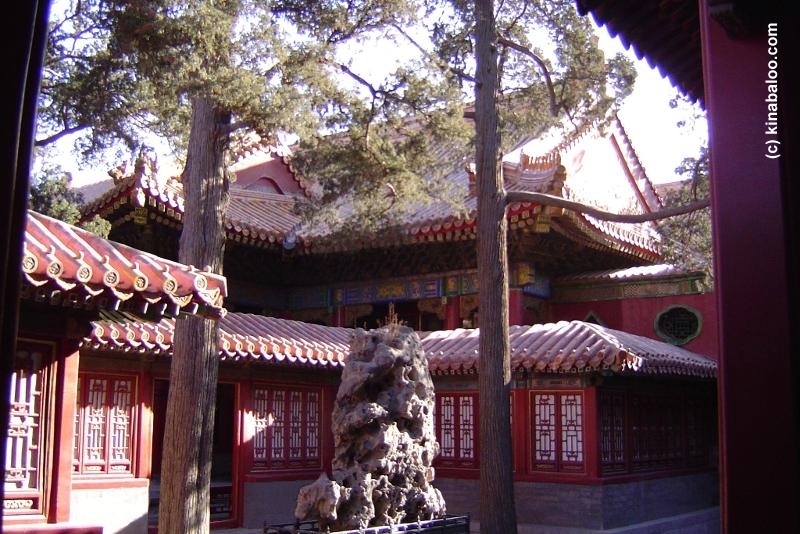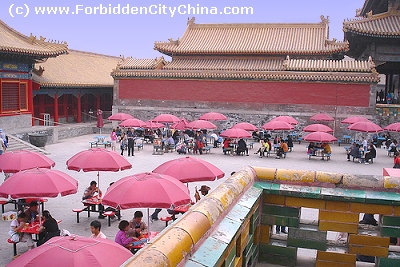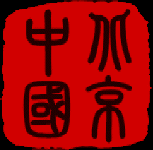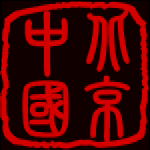Other
Places of Interest
其他有趣的地方

One of the many small courtyards in the
Inner Court.
The Hall of
Mental Cultivation
养心殿
The main building to the west of the
Inner Court is the Hall of Mental Cultivation.
It was built during the Ming Dynasty.
Emperor KangXi of the Qing Dynasty took
this hall as his study. Starting with Emperor YongZheng
(1723-1735), this hall served as the living quarters for
the emperors. Emperor YongZheng also took the central
hall here as his office, where he could deal with state
affairs. As a matter of fact, eight of the Qing Emperors
both lived and worked here. Emperors ShunZhi, QianLong
and TongZhi even died here.
The central hall was the office in
which the emperor met foreign diplomats, and summoned his
officials for consultation. It was also here that the
last emperor in Chinese history, Emperor PuYi, announced
his resignation.
Emperor YongZheng named the western
hall the Hall of Three Rare Treasures. This
referred to three outstanding calligraphy masterpieces by
Wang Xizhi, Wang Xianzhi, and Wang Xun, three pioneers in
Chinese calligraphy. Emperor YongZheng, a great
calligraphy lover himself, had a collection of the
outstanding works by the three Wang's, hence the name.
The emperor's seat is well arranged for
reading and writing, and the writing brushes and
inkstones are placed in proper order. Secret talks on
political and military affairs also took place here. The
screen partition in front was supposed to stop the
secrets from leaking out.
The eastern hall is of historical
significance. This was the site of the well known 'power
behind the throne' or 'behind the screen'. Most people
think that only Empress Dowager Ci'Xi gave audience
behind the screen, but in fact, this was first jointly
practiced by the Empress Dowager Ci'Xi and another
empress called Ci'An. However, the sudden death of
Empress Ci'An in 1881 left the power solely to the
Empress Dowager Ci'Xi. Empress Ci'An was believed to have
been poisoned by Ci'Xi.
Ci'Xi ruled over China for about 40
years from behind the yellow screen. She had to stay
behind the screen all the time because at that time in
China women weren't supposed to be in the Outer Palace or
to hold any public positions! If you have a close look at
the setting here, you will find that a lot of scenes were
shot here for the film 'The Last Emperor', the first
western film made in China.
This last emperor was PuYi just a child
when chosen by Ci'Xi as her next puppet. The next day the
imprisoned emperor was poisoned (probably) but that day
CiXi also died. Within four years came the Republican
revolution and PuYi was forced to abdicate.
内朝西面主要的建筑物就是养心殿,它建于明朝。
清朝的康熙皇帝曾在这学习。从雍正皇帝开始这里变成皇帝的寝宫,他把中间的那间屋子做为办公场所在那学习和处理国家事物。事实上随后的八个皇帝都居住在这里,顺治、乾隆、同治还死在这里。
大殿中间做为办公场所,皇帝有时会在这会见外国使节,或召见大臣议政。中国的最后一个皇帝,溥仪也是在这间屋子宣布退位的。
雍正皇帝把养心殿的西套间命名为"三希堂"。这三个稀世珍宝是指,王羲之、王献之、王珣三个中国书法界的大师的三个帖子。雍正皇帝是个大书法爱好者,它收集了他们最优秀的作品珍藏于此,因此得名。
皇帝的座位被安置到合理的位置,便于读书写字。毛笔、砚台也都按秩序摆放在桌上。有关政治军事的秘密谈话也都在这里进行。放置在前面的屏风就是起到防止秘密外泄的作用。
东大厅在历史上有着重要的意义。这就是众所周知的“宝座后的力量”或“垂帘听政”的地方。大部分的人都意为只有慈禧一个人在垂帘听政,事实上,在最初参与“垂帘听政”的不光有西太后慈禧还有东太后慈安。然而过了不久慈安太后突然于1881年辞世了,留下所有大权给慈禧一个人。都认为慈安是被慈禧毒死的。
就这样慈禧太后在这个黄帘子后面统治了中国大约40多年。她的所有时期都不得不座在帘子后面的,因为那个时候女人是不得在外朝担任任何职务的。如果你仔细看这里的环境,你会发现很多场景都和《末代皇帝》里是一样的。
当最后一个皇帝溥仪被慈禧选中做为她的下一个傀儡的时候,他还只是个孩子。第二天被监禁的光绪帝就死了,但第二天慈禧也死了。四年之后辛亥革命爆发,溥仪被迫退位。
The Six Western
Palaces
东六宫
These palaces are located north of the Hall
of Mental Cultivation, three palaces on each side of
an alley from north to south. They were the living
quarters for the empress and the concubines. The original
layout and decor has been preserved to offer visitors
some ideas about the way of life that the imperial family
led. The original 18th and 19th century furniture is on
display. Also on display are some fine paintings
illustrating the famous novel 'Dream of the Red Chamber'.
The Empress Dowager Ci'Xi lived in the Palace
of Eternal Spring (Chang Chun Gong) during the reign
of TongZhi. The last emperor's wife lived in the Palace
of Accumulated Elegance (Chu Xiu Gong) until 1924
when she and Emperor PuYi were expelled.
In the past, there was a well known
saying - that "3,000 beauties live in the Inner
Court". It actually referrd to those women
(concubines) living in the Six Western Palaces.
When the emperor fancied company at
night, he would write the name of his desired concubine
on paper and the on-duty eunuch would go to fetch her.
She would be stripped naked, to make sure she was without
weapons, then rolled in a rug, carried to the emperor's
chamber and deposited at the foot of the bed. A few of
the emperors were cruel and some of the concubines were
killed.
Apart from the emperor and his sons,
all other males in the Forbidden City were eunuchs,
castrated at start of service, before entry. The purpose
of this was to be sure that any children born belonged to
the emperor.
这些宫殿位于养心殿的北面,有一条南北的小路,每边三个宫殿。这里是皇后和皇妃们的寝宫。最初的规划和装饰仍然保留着,给游客们提供一些关于皇帝家庭生活的思路。最初18和19世纪的家具仍然陈列在那里,还展示了一些关于著名的长篇小说《红楼梦》的精美图画。
在同治统治时期慈禧太后住在长春宫。最后一个皇帝的妻子住在“储秀宫”直到1924年她和溥仪被驱逐出宫。
在过去,有一句很有名的话就是“三千佳丽集于后宫”。实际上被提到的那些嫔妃都住在西六宫。
当晚上皇帝想让人陪的时候,他就会把他想要的女人的名字写在纸上,然后当班的太监就会去找那个女人。她会被脱光,以确保没有武器然,后用毯子卷起来带到皇帝的房间放在床的底部。有些嫔妃会被少数残忍皇帝处死。
除了皇帝和他的儿子之外,故宫里所有的男性都是太监。早在他们进宫服务之前就被阉割了,为的是确保这里所出生的所有孩子都是皇帝的。
The Six
Eastern Palaces
东六宫
The Six Eastern Palaces stand on the
other side of the central north-south axis. Most of these
palaces were restored in the 17th century. They were also
the living quarters for the empresses and concubines.
Today, they have mostly been turned
into special exhibitions such as the Museum of Bronzes
and the Museum of Ceramics.
East of the Six Palaces lie the
store-houses for tea and some of the brocades. The Five
Northern Kitchens (BeiWuChu) to the north fed everyone
living in the eastern part of the inner court.
东六宫位于南北中轴线的另一边。那边的大部分宫殿在17世纪被恢复。那里也是皇后和皇妃的寝宫。
现在大部分都变成了特备的展览官,例如青铜博物馆和陶瓷博物馆。
东六宫也做为仓库存放着茶和一些锦缎。北五厨管着所有住在内宫东边的人的伙食。
The Palace for
Fasting
斋宫
The Emperors were expected to fast the
night before they offered sacrifices to Heaven. As a
general rule, the emperors stayed here for the first two
days of their fast and then moved to an imperial
residence within the confines of the Temple of Heaven.
During the fast, the emperors abstained
from wine, onions, garlic, chives, praying, involvement
in petty affairs and making love. It must have been quite
a task for them!
皇帝在去天坛举行祭祀大典之前要先斋戒。通常按照规则,皇帝会先在这里斋戒两天然后在移往天坛里面的斋宫,斋戒一天。
在斋戒期间,皇帝要禁酒、葱、蒜、韭菜、不能祈祷、不能参与琐事、不能做爱。一定是有很主要的任务等着他们。

 Next
: Doorways Next
: Doorways
 Forbidden City Forbidden City
Introduction
|



